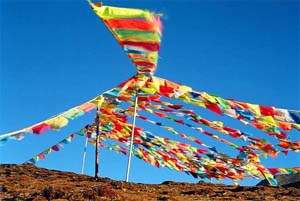| |
Prayer Flags
( 2005-10-27 )
 When travelers see flags of various colors, shapes, and designs blowing in the wind on high mountain passes androof-tops or above rapids in mountain streams, bridges, and monasteries, they know they are somewhere near a Tibetan. The Prayer Flag, or Wind-Horse Flag, can be seen hanging throughout the Tibetan Plateau and indeed, anywhere Tibetans live, such as Sichuan, Qinghai, Gansu, andYunnan provinces as well as in countries neighboring Southeast China's Tibet Autonomous Region, such as Nepal and Bhutan. When travelers see flags of various colors, shapes, and designs blowing in the wind on high mountain passes androof-tops or above rapids in mountain streams, bridges, and monasteries, they know they are somewhere near a Tibetan. The Prayer Flag, or Wind-Horse Flag, can be seen hanging throughout the Tibetan Plateau and indeed, anywhere Tibetans live, such as Sichuan, Qinghai, Gansu, andYunnan provinces as well as in countries neighboring Southeast China's Tibet Autonomous Region, such as Nepal and Bhutan.
These flags, "Lung Ta" in Tibetan, are called "prayer flags" or "wind-horse flags," a literal translation of "Lung (wind) Ta (horse)."
Wind horses of the early stages referred to fleeces hung on the trees or brushwood. Nowadays, the skulls of flocks and herds can still be found among the Mani piles. In the mind of the Tibetans, wind horse refers to mankind's destiny and fortune, and in some special cases it points to the five elements (metal, wood, water, fire, and earth, which the ancients believed composed the entire physical universe, and which were also later used in traditional Chinese medicine to explain various physiological phenomena).
If a wind-horse flag is placed at the convergence of nimbuses (halo-like clouds), the symbols on it will create an offering or prayer, which the wind distributes to the world every time it brushes against the flag. This is believed to be useful for the realization of a person's dreams.
Just like any other art form in Tibet, the creation and distribution of prayer flags is promoted by its religious motif, and at the same time, acts as a medium for religious followers to communicate with the world of spirituality and divinity.
 Legends Legends
There is a legend about the creation of prayer flag: Once a monk obtained an important scripture from India, but unfortunately while he was returning back home, the scripture got wet in a river. Having laid the scripture open to dry in the sunshine, the monk then sat and meditated with his legs crossed under a big tree.
|
|

